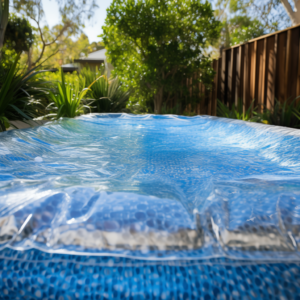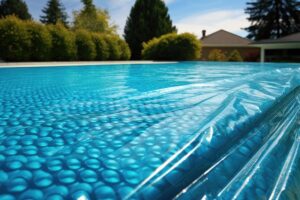Are The Bubbles on a Pool Cover Supposed to be Up or Down?Pool covers serve multiple purposes, including maintaining water temperature, reducing water evaporation, and keeping debris out of the pool. Among the various types of pool covers, solar covers, also known as bubble covers, are particularly popular.
These covers are designed to capture and retain solar energy, thus helping to heat the pool water. The structure of a solar cover is quite distinct, with one side featuring a smooth, flat surface and the other side covered with numerous small bubbles.
The Purpose of the Bubbles
The bubbles on a solar cover play a critical role in its functionality. These bubbles act as insulators, trapping the heat from the sun and transferring it to the water. The air trapped in the bubbles helps in maintaining the pool’s temperature by reducing heat loss during the night or on cooler days. Additionally, the bubbles help in floating the cover on the water surface, ensuring that the entire pool is covered.

Positioning the Bubbles: Up or Down?
The correct positioning of the bubbles is a topic of common confusion among pool owners. The bubbles should be facing down, towards the water. Here’s a detailed explanation of why this positioning is crucial:
1. Maximizing Heat Transfer
When the bubbles are placed downwards, they come into direct contact with the water. This allows the trapped heat within the bubbles to be effectively transferred to the pool water. The bubbles capture the solar energy and act as a medium to transfer this heat directly into the pool. If the bubbles were facing upwards, this direct heat transfer would be significantly less effective, as the heat would have to pass through the smooth layer first before reaching the water.
2. Improving Insulation
The air trapped within the bubbles serves as an insulator. When the bubbles are facing down, the insulating layer is in direct contact with the water, helping to retain the heat more efficiently. This minimizes the heat loss during cooler nights or cloudy days, maintaining a more stable water temperature. Conversely, if the bubbles were facing up, the insulation layer would be less effective as it wouldn’t be in direct contact with the water.
3. Enhancing Buoyancy and Coverage
The bubbles contribute to the buoyancy of the cover, allowing it to float on the water surface. When the bubbles face downwards, the cover sits more evenly on the water, ensuring complete coverage. This helps in preventing debris from entering the pool and reduces water evaporation. If the bubbles were facing upwards, the cover might not float as effectively, leading to gaps and uneven coverage.
Additional Benefits of Proper Positioning
Ensuring that the bubbles are facing downwards not only enhances the primary functions of the cover but also offers additional benefits:
1. Prolonging Cover Life
Proper positioning helps in reducing wear and tear on the cover. When the bubbles face down, they are cushioned by the water, reducing the friction and stress that could occur if they were exposed to the air and external elements. This helps in prolonging the life of the cover, making it a more cost-effective investment.
2. Simplifying Installation and Removal
When the bubbles face down, the cover is easier to handle during installation and removal. The smooth side on top allows for easier manipulation and folding of the cover. It also reduces the risk of the cover getting caught or snagged on pool edges or equipment.

Addressing Common Misconceptions
Despite the clear benefits of having the bubbles facing down, some common misconceptions still persist. Let’s address a few of these:
1. Bubbles Facing Up for Better Heating
Some believe that having the bubbles facing up would expose them more directly to the sun, thereby enhancing heat absorption. While it is true that the bubbles capture solar energy, the heat transfer to the water is more efficient when the bubbles are in direct contact with the water. The primary function of the bubbles is to transfer the captured heat to the pool, not just to absorb it.
2. Easier Cleaning with Bubbles Up
Another misconception is that having the bubbles facing up makes the cover easier to clean. In reality, the smooth surface is less likely to trap dirt and debris compared to the bubbled surface. Having the bubbles down ensures that the smooth side, which is exposed to the environment, is easier to clean and maintain.
Practical Tips for Using a Pool Cover
To maximize the benefits of your solar pool cover, here are some practical tips:
1. Regular Cleaning
Keep your cover clean by regularly hosing it down and removing any debris. This prevents dirt from accumulating on the cover and ensures it remains effective.
2. Proper Storage
When not in use, store the cover in a shaded area away from direct sunlight. This helps in prolonging its lifespan by reducing exposure to UV rays that can degrade the material over time.
3. Cover Reel System
Consider investing in a cover reel system. This makes it easier to deploy and retract the cover, reducing the risk of damage and making it more convenient to use.
4. Regular Inspection
Regularly inspect your cover for any signs of wear and tear. Repair any small damages promptly to prevent them from worsening.
Conclusion
In conclusion, the bubbles on a pool cover should always be facing down towards the water. This positioning maximizes heat transfer, improves insulation, enhances buoyancy, and ensures complete coverage of the pool. Properly positioning the bubbles not only enhances the functionality of the cover but also helps in prolonging its lifespan and simplifying maintenance. By understanding and adhering to these principles, you can ensure that your pool cover serves its purpose effectively, providing you with warmer, cleaner, and more enjoyable swimming experiences.
Read Also.How to get instant hot water under sink?